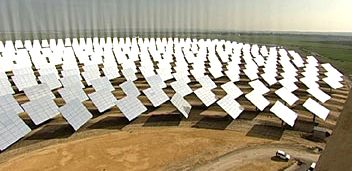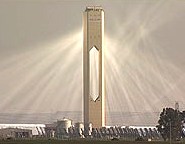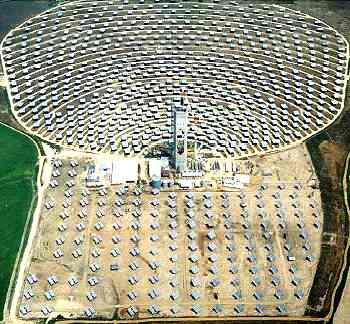|
SPANISH SOLAR THERMO STATION
|
|
HOME | BIOLOGY | FILMS | GEOGRAPHY | HISTORY | INDEX | INVESTORS | MUSIC | NEWS | SOLAR BOATS | SPORT |
|
Spain
Brings On Stream Europe's Largest Thermosolar
Station
"There are 320 days of sunshine a year in Andalusia," says Professor Valeriano Ruiz, director of the thermodynamic laboratory at the University of Seville, who was aghast to find that heavy rain coincided with a visit last week by European journalists to the Sanlucar complex.
The technology of helio-thermodynamism is more productive than electricity production via the photovoltaic -- or solar panels -- method, according to Ruiz. He says it is the only means of providing power on the scale of fossil energy reactors as Spain goes big on the idea of concentrated solar power (CSP).
The first section of the site is ready for inauguration, and once up and running in the coming months it will have an 11 megawatt (MW) capacity, slightly more than its 10-megawatts counterpart at Pocking in Germany, which to date is Europe's largest solar energy producer.
Sanlucar La Mayor will ultimately overtake that as Spain plans to build eight reactors with an overall capacity of 302 MW by 2010. When all eight are on stream that would be sufficient electricity to supply 180,000 homes, the equivalent of a city such as Seville itself.
The Abengoa group has invested 35 million euros (45 million dollars) in the first reactor and expects to shell out a total of 1.3 billion euros by the time the site is complete.
The first reactor covers some 70 hectares and comprises 624 moveable mirrors.
Each has a 121-square-metre surface and is stuck on the end of a metal pillar, enabling the sun's rays to be concentrated on a focal point situated at the top of a tower.
There, a boiler is installed to allow a temperature to be reached of between 600 and 1,000 degrees Celsius in order to heat up fluid and produce the vapour that activates a system of turbines and alternators, thereby generating electricity.
There is no need for silicon, a chemical element indispensable for the fabrication of more expensive photovoltaic cells, and there are no CO2 emissions either, those being the key cause of the so-called Greenhouse Effect of global warming.
What is required is space, at least two hectares per MW of production, and sun -- an annual 1,900 KWh per square metre.
But the sun, unlike oil, is an inexhaustible source of energy -- and it is free, Ruiz notes.
The professor says that the technology has also become financially viable since Spain's Socialists took power in 2004 and passed a law imposing a kilowatt-hour purchase price for solar energy that is more costly than that of other methods.
"It's the real reason why things are starting to take off," he says, adding the ecological side of the argument justifies the state's interest in promoting the technology.
According to Ruiz, the technology is easily exportable to any country where there is an abundance of sunshine, meaning that African states such as Algeria, Egypt and Morocco could see it prosper.
Spain's photovoltaic association ASIF recently forecast growth of up to 1,100 MW by 2010, exceeding government forecasts more than twice over.
Spain, which depends heavily on imported supplies of oil and gas, last year unveiled a Renewable Energy Plan.
The plan offers tax incentives for firms that employ clean emission technologies. It foresees 97 percent of a total 23.6-billion euro investment coming from the private sector, notably such firms as Iberdrola and Gamesa, according to the Institute for the Diversification and Saving of Energy (IDAE).
Spain, where the energy market was deregulated in 1998, is also pushing wind power and lies second only to Germany and just ahead of the United States in terms of installed wind power capacity at 8,155 MW in December 2004.
Solar Tower - Abengoa is a technological company that applies innovative solutions for sustainable development in the infrastructures, environment and energy sectors
There is a scene in one of the Austin Powers films where Dr Evil unleashes a giant "tractor beam" of energy at Earth in order to extract a massive payment.
Well, the memory of it kept me chuckling as I toured the extraordinary scene of the new solar thermal power plant outside Seville in southern Spain.
From a distance, as we rounded a bend and first caught sight of it, I couldn't believe the strange structure ahead of me was actually real.
A concrete tower - 40 storeys high - stood bathed in intense white light, a totally bizarre image in the depths of the Andalusian countryside.
The tower looked like it was being hosed with giant sprays of water or was somehow being squirted with jets of pale gas. I had trouble working it out.
In fact, as we found out when we got closer, the rays of sunlight reflected by a field of 600 huge mirrors are so intense they illuminate the water vapour and dust hanging in the air.
The effect is to give the whole place a glow - even an aura - and if you're concerned about climate change that may well be deserved.
But ultimately, the entire plant should generate as much power as is used by the 600,000 people of Seville.
It works by focusing the reflected rays on one location, turning water into steam and then blasting it into turbines to generate power.
As I climbed out of the car, I could hardly open my eyes - the scene was far too bright. Gradually, though, shielded by sunglasses, I made out the rows of mirrors (each 120 sq m in size) and the focus of their reflected beams - a collection of water pipes at the top of the tower.
It was probably the heat that did it, but I found myself making the long journey up to the very top - to the heart of the solar inferno.
A lift took me most of the way but cameraman Duncan Stone and I had to climb the last four storeys by ladder. We could soon feel the heat, despite thick insulation around the boiler.
It was like being in a sauna and for the last stages the metal rungs of the ladders were scalding.
But our reward was the cool breeze at the top of the tower - and the staggering sight of a blaze of light heading our way from down below.
So far, only one field of mirrors is working. But to one side I could see the bulldozers at work clearing a second, larger field - thousands more mirrors will be installed.
Letting off steam
I met one of the gurus of solar thermal power, Michael Geyer, an international director of the energy giant Abengoa, which owns the plant. He is ready with answers to all the tricky questions.
What happens when the Sun goes down? Enough heat can be stored in the form of steam to allow generation after dark - only for an hour now but maybe longer in future.
Anyway, the solar power is most needed in the heat of summer when air conditioners are working flat out.
Is it true that this power is three times more expensive than power from conventional sources? Yes, but prices will fall, as they have with wind power, as the technologies develop.
Also, a more realistic comparison is with the cost of generating power from coal or gas only at times of peak demand - then this solar system seems more attractive.
The vision is of the sun-blessed lands of the Mediterranean - even the Sahara desert - being carpeted with systems like this with the power cabled to the drizzlier lands of northern Europe. A dazzling idea in a dazzling location.
Solar Tower amid a pitch of aimed mirrors
MADRID, Spain, June 30, 2006 (ENS) - Construction of the first large-scale commercial solar thermal power plant in Europe will soon begin in Spain, about 60 kilometers (40 miles) from the southern city of Granada. The European Investment Bank announced Thursday that it is providing a first 60 million euro installment of funds to the project.
The new concentrating solar thermal power generation plant will have a net capacity of 50 megawatts of electricity.
The city of Granada in southern Spain will be the site of Europe's largest solar thermal generating station.
It will also test a new high temperature thermal storage system utilizing molten salt to extend the daily electricity generation to over 12 hours in winter and up to 20 hours in summer.
The power plant is designed to generate electricity continuously to the grid when in operation.
The project is the first phase of development at this site, a second similar phase is to be implemented shortly after.
Generating power from the renewable solar source will replace the need for more polluting fossil fuel generating stations, contributing to national and European Union efforts to use indigenous renewable energy to avert climate change.
The project supports Spainís policy to develop 200 megawatts of solar thermal generation capacity.
The project benefits from EU research funding and contributes to the deployment and commercialization of new technology, reducing the costs of future applications.
The EU aims to have the new solar thermal technology become cost-competitive with established technology.
To raise energy conversion and operating efficiency and to reduce costs, the Granada project incorporates EU innovative elements that enhance the solar thermal technology developed in the United States.
Immediate social benefits include some 45 permanent new jobs and about 1,000 staff years of temporary jobs during construction.
The finance is being provided to the special purpose company AndaSol-1 Central Termosolar Uno, S.A.. This company is 75 percent owned by ACS, the third largest construction company in Europe.
The remaining 25 percent is owned by Solar Millenium, a German a technology and services company that specializes in large-scale solar thermal power plants.
Sunny Spain is becoming a solar energy center. Last week solar experts from around the world gathered at the 13th annual International Symposium on Concentrating Solar Power and Chemical Energy Techologies. One of the activities was a technical field trip to PS10, a solar thermal tower generating station at Seville.
The PS10, a new 11 megawatt solar thermal tower plant in Seville, Spain is smaller than the facility planned for Granada.
In April, Santander Bank and Madrid-based BP Solar announced they would invest 160 million euros in solar photovoltaic power installations, the largest PVC solar investment in Europe to date.
The agreement reached between the two companies will allow for the construction of up to 278 photovoltaic solar power installations in Spain with total capacity of 18-25 megawatts of power, doubling the current PVC generating capacity in the country.
Each photovoltaic power plant will have an average power between 90 and 100 kilowatts. The construction of the plants began in May and is expected to finish in December 2007.
Santander-BP Solar project is part of a series of initiatives promoted by the private sector within the context of the Kyoto Protocol, and calls for the reduction of the total amount of greenhouse gases emitted in Spain.
To avert global warming, the initiatives aim to substitute non-renewable installed power with installed power drawn on renewable zero-emission sources of energy.
In March, BP Solar announced the completion of the largest photovoltaic installation in the Valencia region in the town of Onda, in Castellon province.
Six solar plants are built on the same site, each owned by a private investor, who all commissioned BP Solar to design the installation, supply the equipment and set up each plant. A total of 3,744 BP solar PVC panels were installed.
The land where these plants have been located have no agricultural use, so BP Solar says the environmental impact of the site has been low. The complex is located in an area where there is no shade and it has been designed to respect the surroundings as far as possible.
Overall, the six installations will generate 828,000 kilowatt hours per year. The total amount of electricity produced by the plants represents a saving of over 800 metric tons of CO2 emissions per year and it is equivalent to a planting of 50,000 trees.
BP Solar estimates that the electricity to be produced is equivalent to the consumption of 200 families.
The Onda project was funded by Spain's Official Credit Institute and the Institute of Diversification and Energy Saving.
Spain is one of the most attractive countries with regard to the development of solar energy, as it has the greatest amount of available sunshine of any country in Europe. Spain is the fourth largest manufacturer in the world of solar power technology and exports 80 percent of this output to Germany.
The Spanish government is committed to achieving the target of 12 percent of primary energy from renewables by 2010 with an installed solar generating capacity of 400 megawatts.
A taste for adventure capitalists
Solar Cola - the healthier cola alternative
|
|
This
website
is Copyright © 1999 & 2007 NJK. The bird |
|
AUTOMOTIVE | BLUEBIRD | ELECTRIC CARS | ELECTRIC CYCLES | SOLAR CARS |


